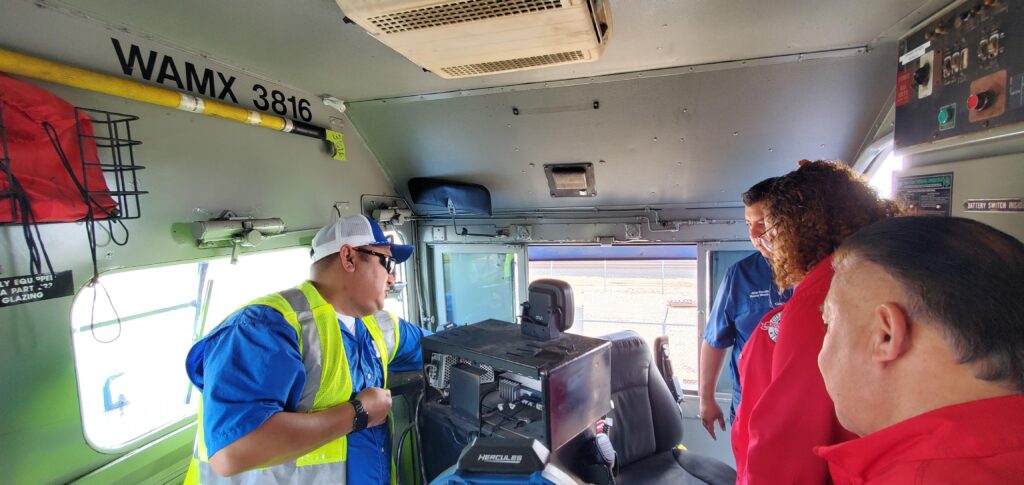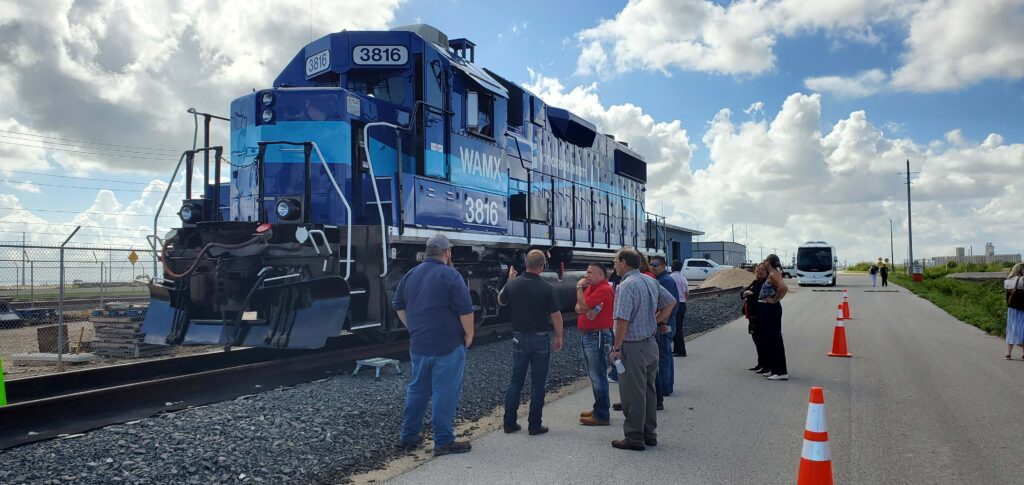Corpus Christi, TX — Recently, local officials from the Texas Department of Transportation, Texas Legislature, and the Corpus Christi area got to experience a side of their city not often seen by the public.
GoRail, in conjunction with Watco and the Port of Corpus Christi hosted officials at the Texas Coastal Bend Railroad, which facilitates rail operations around the port. The tour not only showcased a vital part of the rail network supporting the region’s economic backbone but also highlighted the crucial collaboration between local governance, railways, and maritime operations.

The Texas Coastal Bend Railroad (TCBR) is a prime example of a short line railroad. Unlike major Class I railroads that act as mainline conduits across the country, short line railroads like the Texas Coastal Bend Railroad operate over shorter distances, typically connecting smaller communities and industrial areas to the larger mainline network. These railways play a pivotal role in local economies by efficiently transporting goods from factories, warehouses, and, for the TCBR, ports to broader markets.
“Seeing is believing!” said Ailsa von Dobeneck, assistant vice president with Watco. “We are always proud to host folks onsite and give an overview of what makes the TCBR so impactful. Our team is dedicated to providing customer-focused service at the highest level of safety, and we hope our guests enjoyed the opportunity to board a locomotive as well as see the multimodal campus with our Port counterparts.”
Conversely, railroads are the arteries of trade for ports like Corpus Christi, facilitating the seamless movement of goods between ships and inland destinations. As a critical link in the supply chain, railroads enable ports to handle larger volumes of cargo efficiently, enhancing their competitiveness on a global scale. The synergy between rail and maritime transport is indispensable for the economic vitality of coastal communities, ensuring that products flow smoothly to and from international markets.
Goods moved by the TCBR are a testament to this. Oil and agriculture products, windmill blades, and even military equipment move through the port and the TCBR to destinations around the continent. In the two months leading up to this visit, the TCBR handled grain shipments from as far away as Colorado, Tennessee, and the Yucatan Peninsula in Mexico. Officials got to see dozens of military vehicles loaded up for shipment into the U.S., equipment recently cycled back from overseas missions.
The Port of Corpus Christi ranks among the top U.S. ports for total tonnage, handling a diverse array of commodities.
“I had the pleasure of taking a tour of Watco facilities and a tour of the Port of Corpus Christi rail assets,” said Mike Culbertson, President and CEO of the Corpus Christi Regional Economic Development Corporation. “It was impressive—the coordination it takes to make our economy work. With Watco providing the first and last mile of the logistics chain, I saw many products—liquid, agricultural, raw materials, and military equipment—being moved into the right place at the right time. The assets our region has to offer are impressive, as are the men and women who make this work on a daily basis.”

The port’s strategic location and extensive infrastructure make it a preferred gateway for both imports and exports, fostering economic growth and job creation throughout South Texas. In fact, a multimillion dollar dredging project is currently underway to make the ship channel at the port the deepest on the gulf coast. Interestingly, the dredged material is being siphoned into the nearby delta of the Nueces River, helping to restore and revitalize local wetlands.
The tour underscored the imperative for collaboration between local officials, railroads, and businesses on shared goals of fostering economic development and promoting safety.
By working hand-in-hand, stakeholders can implement robust safety protocols, ensuring that rail operations remain secure and efficient. Moreover, coordinated efforts can bolster infrastructure investments, enhancing connectivity and capacity to accommodate future growth and public safety. Federal grant dollars like those available under the Railroad Crossing Elimination Program present opportunities for communities to invest in their railroads at critical junctures like at-grade crossings. By installing safety equipment or fully separating certain crossings, mobility and safety can be promoted.
Visits like the TCBR tour help representatives from across sectors to learn more about freight operations, investment and expansion plans, and opportunities moving forward. By promoting transparency and education, railroads like the TCBR foster a collaborative environment that prepares regions like Corpus Christi for the transportation challenges of the future.


